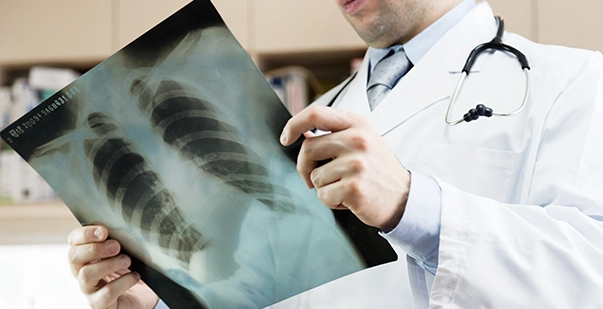A cracked rib is extremely painful and debilitating. It is a very common injury that can happen due to accidents, injuries and impacts. These fractures can significantly affect your way of life and make simple life tasks like breathing, coughing or sneezing unbearably painful.
How to diagnose rib fractures?
To diagnose rib fractures, one needs a combined knowledge of clinical studies, imaging assessment and specialized tests. To prevent potential complications, prompt and accurate diagnosis is a must. Here’s how healthcare professionals usually diagnose and treat rib fractures:
- Clinical Assessment:
- Patient History: Inquire about the mechanism of injury, any associated symptoms, and medical history.
- Physical Examination: Palpate the chest wall for tenderness, deformities, crepitus, and localized swelling. Assess respiratory effort and auscultate for abnormal breath sounds.
- Imaging Studies:
- X-rays: Conventional chest X-rays are often the initial imaging modality used to evaluate rib fractures. They can detect most fractures and assess for associated complications like pneumothorax or hemothorax.
- CT Scans: Computed tomography (CT) scans provide detailed images and are more sensitive than X-rays in detecting rib fractures, especially non-displaced or hairline fractures. CT scans are particularly useful for assessing multiple or complex fractures.
- Specialized Tests:
- Ultrasound: Ultrasonography can be employed for point-of-care assessment, especially in situations where other imaging modalities are unavailable or contraindicated. It is particularly useful for detecting underlying pneumothorax.
- MRI: Magnetic resonance imaging (MRI) may be utilized in certain cases, especially when assessing for soft tissue injuries or suspected complications such as nerve or vascular involvement.
- Differential Diagnosis:
- It’s important to consider other conditions that may mimic rib fractures, such as musculoskeletal injuries (e.g., costochondritis, muscle strain), pleuritic pain, or referred pain from other organs (e.g., abdominal conditions).
- Consultation:
- Depending on the complexity of the case or associated injuries, consultation with specialists such as orthopedic surgeons, pulmonologists, or radiologists may be warranted to ensure comprehensive management.
What is the first-aid for rib fracture?
Administering the appropriate first aid for rib fracture can help a great deal with the pain along with preventing complications and supporting the healing process. Rib fractures demand proper therapy and intervention, but immediate first aid can provide comfort and stability till medical help arrives-
- Encourage the individual to remain calm and still to minimize movement that can exacerbate pain.
- Administer over-the-counter pain relievers such as acetaminophen or ibuprofen, if not contraindicated, to help alleviate discomfort.
- Support the injured area with a firm object (e.g., pillow, folded towel) to minimize movement and provide stability.
- Encourage the individual to avoid activities that involve deep breathing, coughing, or exertion to prevent further stress on the fractured ribs.
- If the individual is experiencing difficulty breathing or shows signs of respiratory distress, assist them into a comfortable position that facilitates breathing.
- Encourage shallow breathing to minimize chest wall movement and reduce pain. However, emphasize the importance of not suppressing coughing entirely, as it helps clear the airways and prevent complications like pneumonia.
- Advise the individual to seek prompt medical evaluation, especially if they experience severe pain, difficulty breathing, or if there is suspicion of associated injuries such as pneumothorax or internal bleeding.
- Transport the individual to the nearest medical facility for further assessment and treatment by trained healthcare professionals.
- Stay with the individual and monitor their condition closely. Look out for any signs of deterioration, such as increasing pain, shortness of breath, or changes in consciousness.
- Be prepared to administer CPR if the individual becomes unresponsive and stops breathing.
- After initial first aid, encourage the individual to follow up with a healthcare provider for further evaluation and management of the rib fracture.
- Emphasize the importance of adhering to any prescribed treatment plan and instructions for optimal recovery.
Conclusion
The successful treatment for a cracked rib requires a multidisciplinary approach. It involves collaboration between healthcare professionals, effective communication and patients. It is also exceptionally important to adhere to evidence based practices. The empowerment of individuals and the awareness of first aid for cracked ribs can facilitate timely intervention and management of common yet challenging injury.













